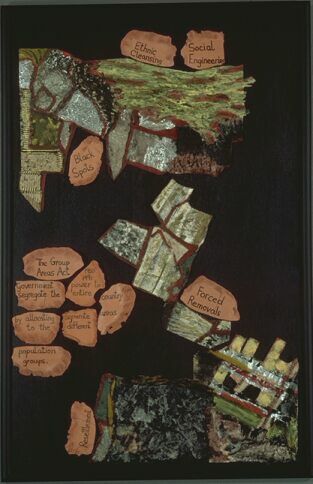![]()
Black Spots refers to another element in the context of life in South Africa during Apartheid. South Africa's laws, most of which were passed by the Nationalist Party led government since 1948 provided for control of where black South Africans lived, worked and played.

28" x 18" Mixed Media (1999)
South Africa developed a complex legal framework for dividing up the country into a patchwork of areas designed to keep the various ethnic groups apart. The designation of Black Spots was for land that was to be inhabited only by black South Africans but which did not belong to one of the ten homelands. These areas lacked infrastructure and typically were the least desirable parcels, often totally barren and devoid of potential sustainability. White South Africans were not allowed to inhabit these areas nor operate commercial enterprises therein. Black Spots were often found on the perimeters of white urban areas.
On an even more micro level, South Africa passed and strictly enforced a myriad of laws which controlled which amenities were reserved for blacks and stipulated separate facilities wherever possible. Even in a post-office, there were separate entrances for whites and blacks and park benches had signs indicating the racial group permitted to sit on them. These laws were similar to the 'Jim Crow laws' which enforced racial segregation in the U.S. South between 1877 and the 1950's, the start of the Black Civil Rights movement in the USA.
One of the most hated and feared laws in South Africa was the Natives Abolition of Passes and Coordination of Documents Act which was passed in 1952. This required all black people over the age of 16 to carry a passbook and present it to police on demand. The passbook included personal identification and information on employment, poll tax and influx control. Any black person found in an area who did not either hold current employment there or have an official endorsement showing permission to be there or it was not their place of birth was immediately subject to arrest, fines and deportation to the place of their birth or designated homeland. It was through laws like this that the government was able to tightly control the movements of blacks and effectively implement the policy of Apartheid. The Pass Laws were repealed in 1986.
Since democratic elections in 1994 all legislation designating and enforcing Black Spots has been repealed, though many millions of people still live in these economically depressed and impoverished areas. Despite the massive migration to the cities and the much slower growth of new jobs, many people remain in these areas unable or unwilling to move. They are hoping to improve their current situation rather than risk the uncertainties and violence that is escalating in the cities. The S.A. government's Reconstruction and Redevelopment Program has set goals for bringing basic infrastructure such as electrification and running water to these depleted areas.
![]()